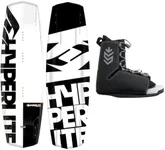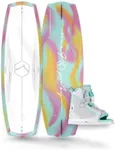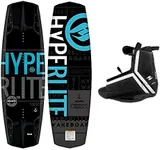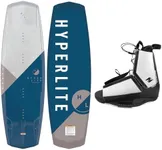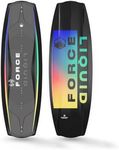Buying Guide for the Best Wakeboards
Choosing the right wakeboard can significantly enhance your experience on the water. Whether you're a beginner or an experienced rider, selecting a wakeboard that matches your skill level, riding style, and physical attributes is crucial. Understanding the key specifications will help you make an informed decision and ensure you have the best possible ride.LengthThe length of a wakeboard is crucial because it affects the board's stability, speed, and maneuverability. Shorter boards (less than 130 cm) are generally more maneuverable and better for tricks, making them suitable for lighter riders or those who prefer a more playful ride. Medium-length boards (130-140 cm) offer a balance of stability and agility, ideal for intermediate riders. Longer boards (over 140 cm) provide more stability and are better for beginners or heavier riders. Choose a length that matches your weight and skill level to ensure a comfortable and enjoyable ride.
Rocker TypeThe rocker type refers to the curvature of the wakeboard from tip to tail. There are three main types: continuous, three-stage, and hybrid. Continuous rockers have a smooth, curved shape that provides a fast and predictable ride, making them great for carving and smooth transitions. Three-stage rockers have distinct flat spots that create more pop off the wake, ideal for riders who want to perform aerial tricks. Hybrid rockers combine elements of both, offering a versatile ride. Consider your riding style and what you want to achieve on the water when choosing a rocker type.
WidthThe width of a wakeboard affects its surface area and buoyancy. Wider boards provide more surface area, which can help with stability and make it easier to ride at slower speeds. They are great for beginners or those who prefer a more stable ride. Narrower boards are more agile and responsive, making them suitable for advanced riders who want to perform quick turns and tricks. Choose a width that matches your skill level and riding style to ensure you have the right balance of stability and maneuverability.
FinsFins are located on the bottom of the wakeboard and help with tracking and stability. Larger fins provide more stability and are better for beginners who need help staying straight. Smaller fins offer less resistance and are better for advanced riders who want to perform tricks and need more maneuverability. Some wakeboards come with removable fins, allowing you to customize your ride. Consider your skill level and the type of riding you plan to do when choosing the fin setup.
FlexFlex refers to how much the wakeboard bends under pressure. Stiffer boards provide more pop and are better for aggressive riding and performing tricks. Softer boards offer a smoother ride and are more forgiving, making them suitable for beginners or those who prefer a more relaxed ride. Consider your riding style and what you want to achieve on the water when choosing the flex of your wakeboard.
BindingsBindings are the boots that attach your feet to the wakeboard. They are crucial for comfort and control. Open-toe bindings are more adjustable and can accommodate a range of foot sizes, making them great for beginners or families who share a wakeboard. Closed-toe bindings offer a more secure fit and better performance, ideal for advanced riders. Make sure the bindings fit snugly and provide good support to ensure a comfortable and controlled ride.


